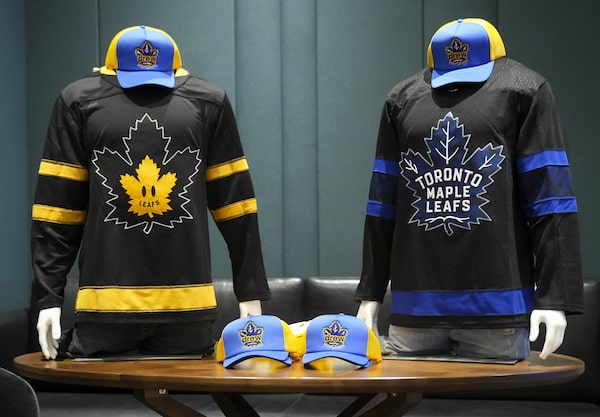
Toronto Maple Leafs unveil their alternate 'Next Gen' jersey, which was created in a partnership with Canadian musician Justin Bieber, Drew House, NHL and Adidas, in Toronto on March 21.Nathan Denette/The Canadian Press
Memorabilia collector Glen Pye noted a shift in the world of sports merchandise when teams began selling game-used apparel and equipment.
There was a secondary market for rare collectibles, but he says it was the first time leagues and franchises actively stepped outside their mass-produced comfort zones and into the world of limited-edition merchandising. “That was probably the first thing they started with, and all the teams did it at the same time.”
Following the sales successes of game-used equipment, which began about 30 years ago, sports brands have recently decided to offer fans a wider range of exclusive and limited products.
“Merchandise used to be shirts, hats, souvenir pucks, just odds and ends like that. Now they’ve morphed, because they saw how much money we were getting in the collectibles and memorabilia market,” says Pye, who owns and operates Toronto-based Glory Days Collectibles. “We didn’t really compete with merchandise, but we are to a certain extent now.”
Fandom has long been expressed through accessories and apparel. Sports teams have been increasingly selling items that are limited in quantity, or only available for certain periods of time, blurring the line between merchandise and memorabilia. It’s especially true in Toronto, where two of the country’s biggest sports franchises are closely affiliated with two of Canada’s most popular musicians.
The Toronto Raptors released the NBA team’s first “alternate” black-and-gold jersey in 2015, as part of a partnership with global ambassador Drake. The design soon became a top seller, far outpacing the traditional “home” and “away” jerseys the team had exclusively sold prior.
Since 2018, team owner Maple Leaf Sports & Entertainment (MLSE) has been launching a “City Edition” collection on a limited, year-long basis each season, with the latest design unveiled to the public on Nov. 10. “Those are our No. 1 selling Raptors jerseys, hands down,” says MLSE’s chief marketing officer Shannon Hosford.
The latest City Edition jersey, developed in collaboration with Drake’s apparel brand OVO, includes the word “North” in a variety of languages, and features a subtle nod to Toronto’s six boroughs. In March, MLSE, which also owns the NHL’s Toronto Maple Leafs, sought to replicate that winning formula when it teamed up with Justin Bieber’s Drew House apparel line to develop an alternate Maple Leafs jersey.
“We launched that in-and-around our Next Gen game, and that was the No. 1 selling jersey in our store’s history,” Hosford says. “It turned out to be the No. 1 third-jersey (not ‘home’ or ‘away’) sale in NHL history.”
Hosford adds that the limited editions provide benefits to fans looking to find new ways to engage with their favourite teams, to collaborators such as Bieber and Drake who want to reach new audiences, and to sports franchises aiming to leverage their celebrity ties.
“We work to associate with Drake and Bieber to amplify our brands to new audiences and connect with different audiences that they’re connected to,” she says. “We’ve unlocked something very special here, and it goes back to that sense of connection that we have with those two individuals. That is unique.”
That pattern holds true in the newly emerging world of digital collectibles, where fans are able to collect limited-edition assets known as non-fungible tokens, or NFTs, featuring their favourite players and teams.
“It very much is a symbiotic relationship in that regard,” explains Adam Barrick, vice-president of sports for Dapper Labs. The Vancouver-based provider of digital collectibles has exclusive partnerships with the NBA, NFL, UFC and other leagues. “The questions [stakeholders and partners] are asking aren’t around revenue, they’re around engagement, and what sort of enhanced fan-engagement products like ours can create for them.”
Barrick says sports memorabilia is often viewed as both a collector’s item and an expression of fan engagement, adding that – despite the NFT speculation frenzy of last year – the products are designed for fans, not investors.
“We’re not looking to cater ourselves to a community that’s treating it as an investment, we’re a vehicle for fandom,” he says. “If you skew more toward those looking at it from an investment perspective, you’re not appealing to the mass audience, you’re appealing to a very niche subset, and you’re undercutting the whole premise of what our business is, and what our relationship is with our league rights holders.”
Limited-edition collectibles are generally lucrative for leagues, teams and their merchandise partners, with items in limited supply fetching a higher price than mass-produced alternatives. At the same time Barrick argues one key reason these types of collaborations are taking off is because of their effect on fan engagement, which is the most important metric for most sports brands.
Just as Drake and Bieber can help attract new Raptors and Leafs fans, he says he believes the global nature of digital collectible products can help expand the geographic reach of players and teams.
“We’re digital, we’re global, we’re extremely engaging, and we have the ability to create better fans. … Different kinds of fan engagement is critically important for rights holders across the spectrum, and we have data that supports us being a vehicle for that.”